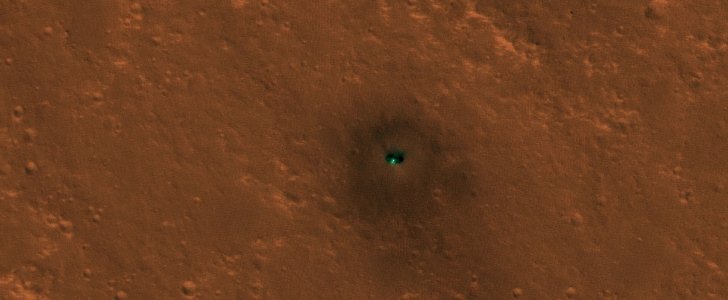Earlier this week, the InSight spacecraft currently on location on Mars sent back to the home planet its first selfie. Now, other photos showing NASA’s most exciting Martian project in years reached us, courtesy of the Mars Reconnaissance Orbiter (MRO).
MRO is equipped with the High Resolution Imaging Science Experiment (HiRISE) camera, a tool which it normally uses to capture images of the Martian surface. Earlier in December, MRO used the HiRISE to capture images on the recently deployed InSight.
There’s a set of three photos released by NASA, the first showing the parachute that helped the ship reach the soil safely, the second the heat shield that kept it from burning up when entering the atmosphere and the third the lander itself in its current position.
Being taken from several miles up, the photos are not all that clear, and all the elements show up as bright objects, spread within 1,000 feet (several hundred meters) of one another.
The most distinguishable of these objects is the lander itself, not necessarily because it is the biggest, but also because there’s a rather large circle of charred soil around it.
This is because of the retro-boosters used in the final stages of descent to slow the spacecraft down.
The spacecraft landed in a lava plain called Elysium Planitia, where it will stay for the duration of its mission.
InSight is a very important tool in determining the way in which Mars works. It will look for quakes, perturbations of Mars' rotation axis, information about the planet's core or the amount of heat escaping from underneath as a means to learn more about the formation of rocky planets.
To be able to properly conduct its work, InSight will have to precisely place the SEIS (Seismic Experiment for Interior Structure), RISE (Rotation and Interior Structure Experiment) and HP3 (Heat Flow and Physical Properties Package) instruments on the surface and start digging holes into the reddish soil.
Operations are expected to commence as soon as next month.
There’s a set of three photos released by NASA, the first showing the parachute that helped the ship reach the soil safely, the second the heat shield that kept it from burning up when entering the atmosphere and the third the lander itself in its current position.
Being taken from several miles up, the photos are not all that clear, and all the elements show up as bright objects, spread within 1,000 feet (several hundred meters) of one another.
The most distinguishable of these objects is the lander itself, not necessarily because it is the biggest, but also because there’s a rather large circle of charred soil around it.
This is because of the retro-boosters used in the final stages of descent to slow the spacecraft down.
The spacecraft landed in a lava plain called Elysium Planitia, where it will stay for the duration of its mission.
InSight is a very important tool in determining the way in which Mars works. It will look for quakes, perturbations of Mars' rotation axis, information about the planet's core or the amount of heat escaping from underneath as a means to learn more about the formation of rocky planets.
To be able to properly conduct its work, InSight will have to precisely place the SEIS (Seismic Experiment for Interior Structure), RISE (Rotation and Interior Structure Experiment) and HP3 (Heat Flow and Physical Properties Package) instruments on the surface and start digging holes into the reddish soil.
Operations are expected to commence as soon as next month.




